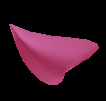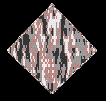

@c draws a 2 dimensional disk in the plane defined by the turtle's heading vector and left vector (see Figure 2.1). The diameter is determined by the turtle parameter line width and the position of the origin is determined by the current x and y coordinates of the turtle.
@O draws a 3 dimensional sphere. The diameter is determined by the turtle parameter line width and the position of the origin is determined by the current x and y coordinates of the turtle.
|
Example:
The following production draws a smaller sphere connected to a larger sphere by a straight
Lsystem: 0 derivation length: 1 Axiom:X homomorphism X --> @O(2)F(6)@O(3) endlsystem
|
|
Example:
The following L-System draws a molecule with four atoms connected to
the center of
#define STEPS 3 #define TET 70.5 /* 180 - 109.5 */ #define C_SIZE 0.6 #define H_SIZE 0.5 Lsystem: 0 derivation length: STEPS Axiom: ,(1)#(0.15)|X X --> HFC[^(TET)FH]/(120)[^(TET)FH]/(120)[^(TET)FH] C --> [,(2)@O(C_SIZE)] H --> [,(3)@O(H_SIZE)] endlsystem
|
 |
 |
 |
 |
 |
Preface Parameters Appendix I Appendix II References |
|---|---|---|---|---|---|
| Index | Circles and Spheres | Generalized Cylinders | Surfaces | Textures |